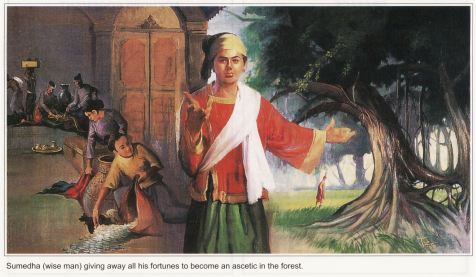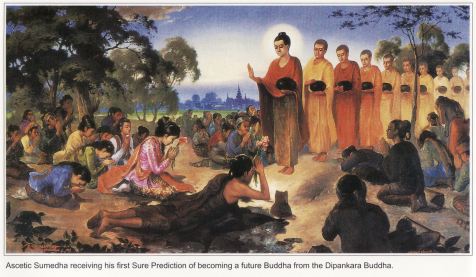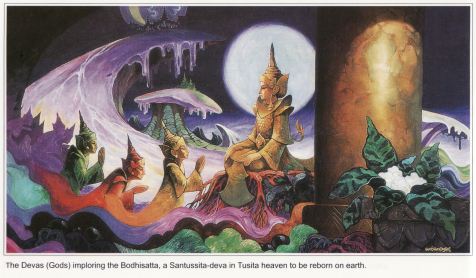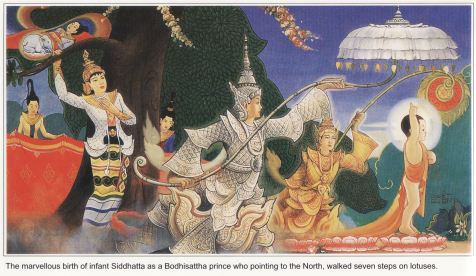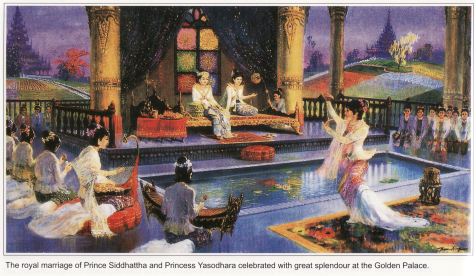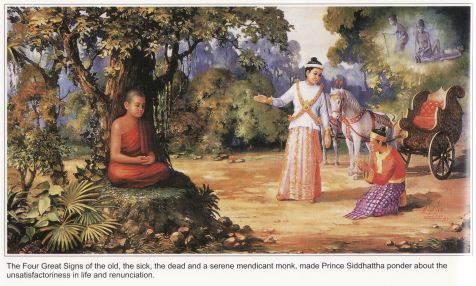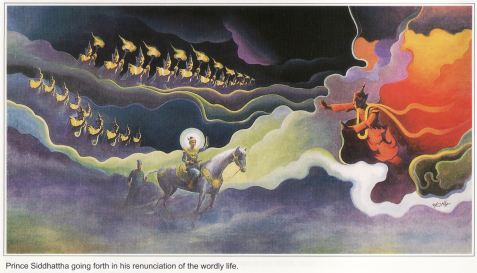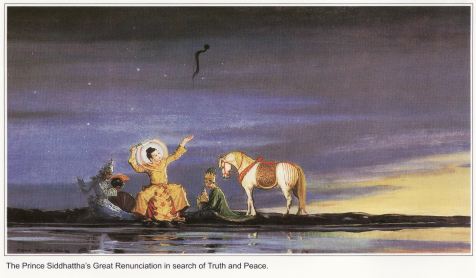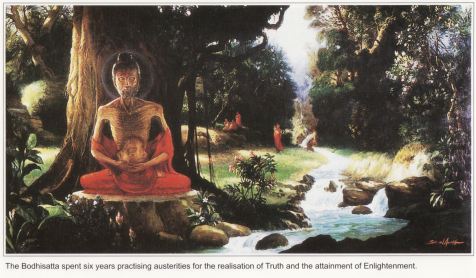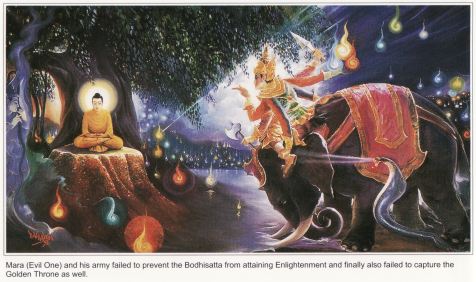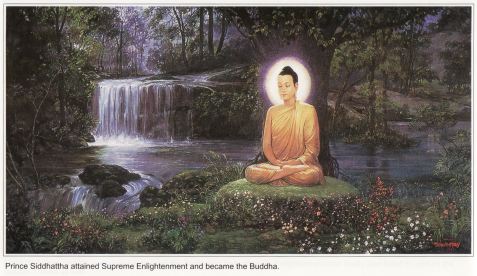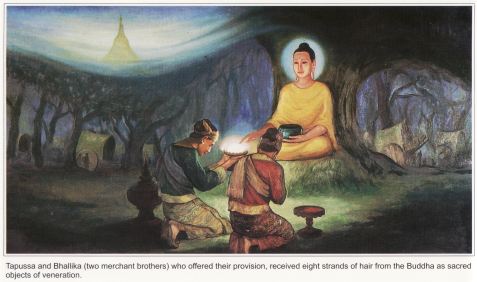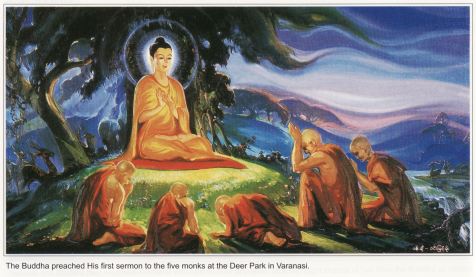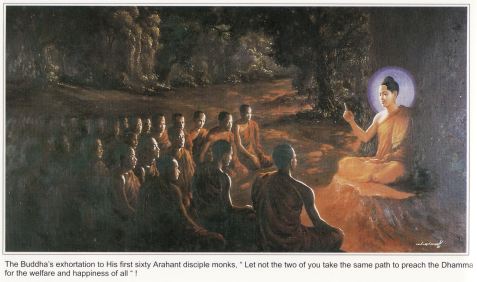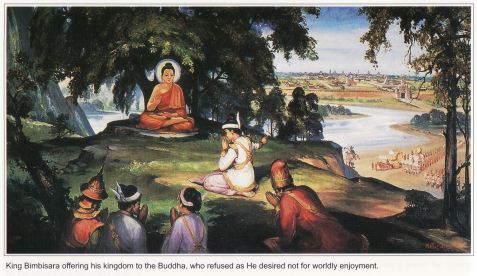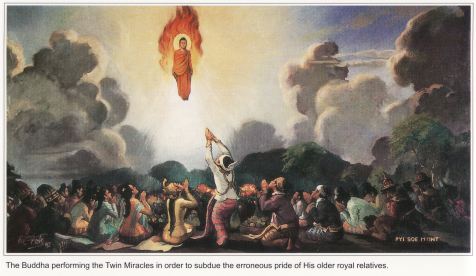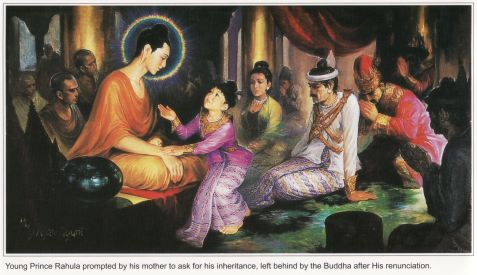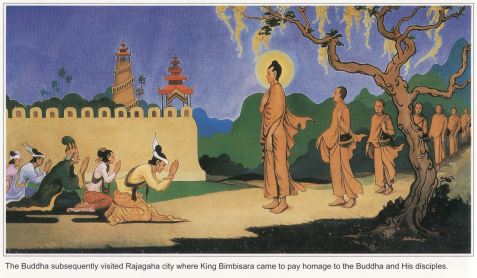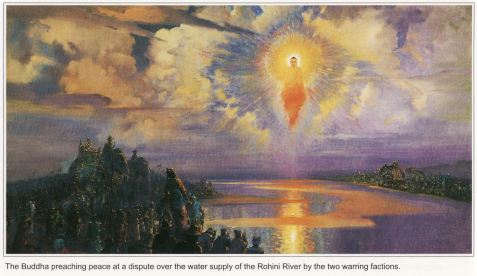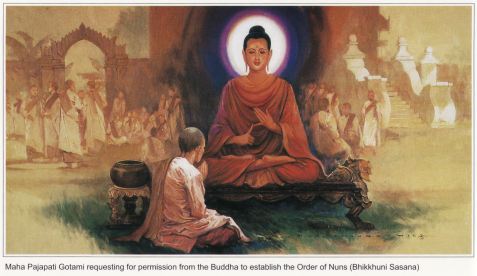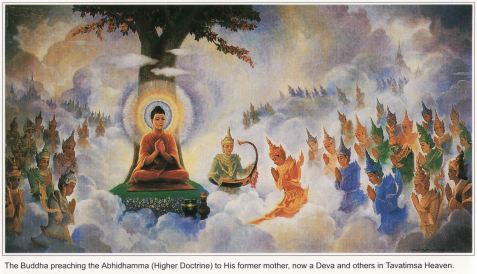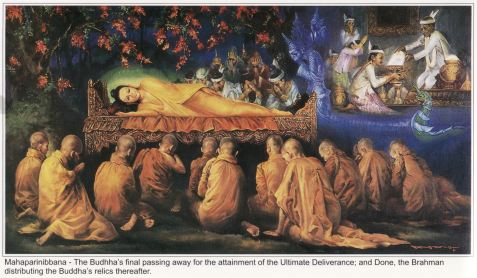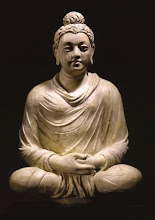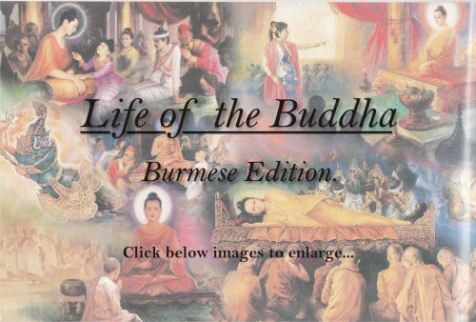
.
.
This beautiful ‘Life of the Buddha’ pictorial book from Dhammikarama Burmese temple, penan, Malasia.
Sadhu! Sadhu! Sadhu!
這個美麗的'生命的佛陀畫冊從 Dhammikarama緬甸寺廟,檳城 。
Sadhu! Sadhu! Sadhu!苦行僧!苦行僧!苦行僧!
.
.
SUMEDHA, the wise man inherited a vast fortune from his parents who left them upon their deaths. Realizing the unsatisfactoriness he gave away his fortune and became an ascetic in
the forest. He soon gained mastery in meditation and was well known for
his supernormal powers.
SUMEDHA,聰明的人繼承了巨額財富從他們的父母誰離開後,他們的死亡。 Realizing the unsatisfactoriness he gave away his fortune and became an ascetic in the forest.實現 unsatisfactoriness還是答應了他的財富,成為一個苦行者在森林裡。 He soon gained mastery in meditation and was well known for his supernormal powers.他很快就掌握在冥想和獲得是眾所周知的,他超常的權力。
.
.
When ascetic Sumedha knew of the coming of Dipankara Buddha to the city of Rammavati, he took part in preparing the road for the Buddha. He was
still repairing it when the Buddha arrived but he was determined to
complete it by prostrating himself into the muddy hollow, in
fulfillment of his vow to become a Buddha. Beside him was a young lady
named Sumitta bearing eight stalks of lotus flowers. She gave the
Ascetic five stalks and kept for herself three stalks for her own
aspiration. When the Buddha Dipankara saw this, He omnisciently
declared the Ascetic Sumedha a future Buddha, while He stated that the
aspiring young lady Sumitta would be his constant companion and
helpmate.
當苦行Sumedha知道未來的燃燈佛該市 Rammavati,他參加了籌備道佛。 He was still repairing it when the Buddha arrived but he was determined to complete it by prostrating himself into the muddy hollow, in
fulfillment of his vow to become a Buddha.他還在修復它時,佛來,但他決心要完成自己的IT叩頭到馬迪霍洛,在履行他的誓言,成為佛。 Beside him was a young lady named Sumitta bearing eight stalks of lotus flowers.他旁邊是一個年輕的女士叫Sumitta軸承八蓮花莖。 She
gave the Ascetic five stalks and kept for herself three stalks for her
own aspiration. When the Buddha Dipankara saw this, He omnisciently
declared the Ascetic Sumedha a future Buddha, while He stated that the
aspiring young lady Sumitta would be his constant companion and
helpmate.她給了苦行五秸稈和秸稈保存自己為自己的三個願望。燃燈佛時看到這一點,他omnisciently宣布苦行Sumedha一個未來佛,而他說,有抱負的年輕小姐Sumitta將成為他的忠實的夥伴和幫手。
.
.
The Devas (Gods) imploring the Bodhisatta Santussita Deva (whose real name was Setaketu) in Tusita heaven to be reborn on earth to become a
Buddha. He accepted their request after viewing the Five Great
Considerations (Panca Maha Vilokana); which are appropriate time,
Island-continent, country, clan and life-span of mother.
天神(神)懇求菩薩 Santussita德瓦(本名是Setaketu)在兜率天獲得重生,成為地球上的佛。 He accepted their request after viewing the Five Great Considerations (Panca Maha Vilokana); which are appropriate time, Island-continent,
country, clan and life-span of mother.他接受了他們的要求,在查看完五大注意事項(Panca瑪哈 Vilokana),這是適當的時候,島洲,國家,部族和壽命的母親。
.
.
At Lumbini Park in Nepal, on Vesakha Full Moon Day, the newly born Prince walked seven steps on the lotus flowers and pointing to the North said,
“AGGOHAM ASMI LOKASSA” meaning “Chief Am I in this world”. The birth of
this baby Prince brought great joy to his royal parents, King
Suddhodana and Queen Maha Maya as well as all beings!
在尼泊爾藍毘尼園,在Vesakha月圓日,新出生的王子走了七步蓮花上,指著北方說:“AGGOHAM阿拉斯加海產市場協會 LOKASSA”,意思是“行政上午我在這個世界”。 The birth of this baby Prince brought great joy to his royal parents, King Suddhodana and Queen Maha Maya as well as all beings!這個嬰兒的誕生王子如痴如醉他的父母,國王淨飯王和王后詩瑪雅以及所有的人!
.
The marriage of Prince Siddhattha and Princess Yasodhara (whose real name was BaddaCancana ) took place at the Golden Palace which was presented
by his father, King Suddhodana. It was a luxurious palace full of
comforts of life . The celebration lasted many days.
悉達多王子的婚姻和公主Yasodhara(本名是BaddaCancana)發生在金宮是由他的父親介紹,國王淨飯王。 It was a luxurious palace full of comforts of life .這是一個充滿了舒適豪華的宮廷生活。 The celebration lasted many days.慶祝活動持續了很多天。
During his visit to the Royal park, Prince Siddhattha saw the Four Great Signs, namely — an old man, a sick man, a corpse and a serene
mendicant. These made the Prince to realize the unsatisfactoriness of
life and urged him to ponder deeply about renunciation.
在訪問英國皇家公園,太子悉達多看到了四大症狀,即 - 一個老人,一個病人,一具屍體和一個寧靜的乞討。 These made the Prince to realize the unsatisfactoriness of life and urged him to ponder deeply about renunciation.這些使王子,實現 unsatisfactoriness的生活,並敦促他深入思考關於放棄。
Mara (the Evil One), with his host tried without success to prevent Prince Siddhattha from his Great Renunciation at midnight . Prince Siddhattha
was riding on Kanthaka his fovourite stallion and followed by Channa
his loyal charioteer. Mara said that if the prince did not proceed on
his renunciation, he would become a Universal Monarch on the seventh
day.
瑪拉(魔鬼),與他的主人嘗試沒有成功阻止他的大王子悉達多放棄在午夜。 Prince Siddhattha was riding on Kanthaka his fovourite stallion and followed by Channa his loyal charioteer.悉達多王子騎在Kanthaka他fovourite種馬和他的忠實其次鱧車夫。 Mara said that if the prince did not proceed on his renunciation, he would become a Universal Monarch on the seventh day.馬拉說,如果王子沒有放棄他繼續下去,他會成為一種普遍君主的第七天。
. 。
Prince Siddhattha cut off his hair to renounce the worldly life at the bank of the Anoma River. Ghatikara Maha Brahma presented the Monk’s Eight
Requisites to Ascetic Siddhattha, who commanded his charioteer Channa
to take his royal chattels back to the palace.
His hair was received by Sakka, King of Gods and enshirned in CULAMANI
CETI (pagoda) in his celestial abode in TAVATIMSA. Similarly, Ghatikara
Maha Brahma bore his princely clothes to his higher celestial abode,
Akanittha and enshrined them in the pagoda known as DUSSA CETI.
悉達多王子切斷他的頭髮,放棄世俗生活,在銀行的Anoma河。 Ghatikara Maha Brahma presented the Monk's Eight Requisites to Ascetic Siddhattha, who commanded his charioteer Channa to take his royal
chattels back to the palace. Ghatikara瑪哈梵天介紹和尚的八大要件到苦行悉達多,誰指揮他的charioteer鱧把他的皇家動產回到皇宮。
His hair was received by Sakka, King of Gods and enshirned in CULAMANI CETI (pagoda) in his celestial abode in TAVATIMSA.他的頭髮收到Sakka,神與國王在CULAMANI enshirned鯨魚座(塔)在他的天體居TAVATIMSA。 Similarly, Ghatikara Maha Brahma bore his princely clothes to his higher celestial
abode, Akanittha and enshrined them in the pagoda known as DUSSA CETI.同樣,Ghatikara瑪哈梵天有他的衣服給他的更高的王侯天體居留權,Akanittha和體現他們在鯨魚座佛塔稱為 DUSSA。
The ascetic Bodhisatta spent six years practising austerity and meditation with steadfastness as well as earnestness, prior to his attainment.
Even though he was reduced to a mere skeleton, he did not give up
practising.
苦行菩薩花了六年時間練習冥想與緊縮和堅定性,以及認真,之前,他的實現。 Even though he was reduced to a mere skeleton, he did not give up practising.儘管他減少到了骨瘦如柴,他並沒有放棄修煉。
The Bodhisatta was sitting on a Golden Throne under a Bodhi tree and being challenged by Mara (the Evil One) riding on the ferocious elephant
Girimekhala. Mara with host tried to capture the Golen Throne just
before the Bodhistta’s Enlightenment.
該菩薩坐在黃金的寶座和菩提樹下受到挑戰,瑪拉(魔鬼)騎在兇猛的大象Girimekhala。 Mara with host tried to capture the Golen Throne just before the Bodhistta's Enlightenment.瑪拉與東道國試圖捕捉Golen寶座前的Bodhistta的啟示。
On Vesakha Full Moon day, Bodhisatta Siddhattha seated under a Bodhi tree at Gaya, attained Supreme Enlightement. On the first watch of the night
he gained knowledge by which He remembered past lives. On the second
watch of the night he was able to see into the future including the
birth and death of other beings. On the third watch of the night, He
destroyed all defilements and became a Fully Enlightened One
(Samma-Sambuddha).
在Vesakha月圓日,菩薩悉達多坐在菩提樹下,在加耶,達到最高的啟示。 On the first watch of the night he gained knowledge by which He remembered past lives.在第一次觀看了晚上,他所獲得的知識,其中他想起過去的生活。 On the second watch of the night he was able to see into the future including the birth and death of other beings.在第二個晚上,他看的是能看到未來,包括出生和死亡的其他人。 On the third watch of the night, He destroyed all defilements and became a Fully Enlightened One (Samma-Sambuddha).在第三次觀看了晚上,他銷毀了所有煩惱,成為全覺者(Samma - Sambuddha)。
It was in the final week (7th week) after his Enlightenment, when the two merchant brothers Tapussa and Bhallika from Ukkalapa passed by the spot
and saw the Buddha. They offered the Buddha their own provision; then
the Buddha gave eight strands of hairs from His head for them to
worship as sacred objects of veneration.The hair relics are now
enshrined in the Shwedagon Pagoda in Yangon, Myanmar.
這是在最後一個星期(7週)後,他的啟蒙運動,當兩兄弟Tapussa和Bhallika商人從 Ukkalapa通過現場,看到了佛。 They offered the Buddha their own provision; then the Buddha gave eight strands of hairs from His head for them to worship as sacred objects of
veneration.The hair relics are now enshrined in the Shwedagon Pagoda in
Yangon, Myanmar.他們提供了他們自己的規定佛,然後給了八佛鏈的頭髮從他的頭部為他們崇拜的聖物的veneration.The頭髮文物現供奉在大金塔緬甸仰光。
At the Deer Park at Varanasi, the Buddha met the five ascetics, Kondanna, Vappa, Bhaddiya, Mahanama and Assaji all of whom He had known before
.He delivered His first sermon to them. It is called the
Dhammacakkapavattana Sutta which sets the wheel of the Dhamma in
motion. The ascetic Kondanna who was at His childhood Name-giving
Ceremony became the first to see light in the Dhamma and attained
Sotapanna, the first stage of Sainhood.
Later, all attained Arahantship after hearing the Anatalakkhana Sutta (the Discourse which deals with No-Self)
在鹿園在瓦臘納西,佛會見了五個苦行者,Kondanna,Vappa,Bhaddiya,摩訶男和阿說示人,他都知道的。他發表了他的第一次講道給他們。 It is called the Dhammacakkapavattana Sutta which sets the wheel of the Dhamma in motion.這就是所謂的Dhammacakkapavattana經文這台輪佛法的議案。 The ascetic Kondanna who was at His childhood Name-giving Ceremony became the first to see light in the Dhamma and attained Sotapanna, the first
stage of Sainhood.苦行Kondanna誰是在他的小名,頒獎典禮,成為第一個看到光在正法並取得Sotapanna,第一階段 Sainhood。
Later, all attained Arahantship after hearing the Anatalakkhana Sutta (the Discourse which deals with No-Self)後來,所有達到 Arahantship聞訊後 Anatalakkhana經文(其中涉及的話語無自我)
The Buddha exhorted His first sixty Arahant disciples to go forth in different directions to preach the Doctrine, using these famous words:
– “Go ye, 0 bhikkhus and wander forth for the gain of many, for the
welfare of the many, in compassion for the world, for the good, for the
gain, for the welfare of the Devas (Gods) and men . Proclaim ye, 0
Bhikkhus! The Doctrine that is glorious and preach ye a life of
holiness, perfect and pure!”
佛陀告誡他的前60阿羅漢弟子出去不同方向宣講教義,利用這些著名的話: - “你們要去,0比丘和漂移的增益提出了許多,許多的福利,在同情世界,為善,為增益,為社會福利的天王(神)和男子。 Proclaim ye, 0 Bhikkhus!你們宣布,0比丘! The Doctrine that is glorious and preach ye a life of holiness, perfect and pure!”該學說認為是光榮的,你們宣揚聖潔的生活,完美和純粹嘛!“
When the Bodhisatta visited Rajagaha, the capital of Magadha, King Bimbisara offered his Kingdom to the Bodhisatta. But He did not accept it because
of the worldly pleasures. After listening to the preaching of Buddha,
the King attained the first stage of Sainthood (Sotapanna). He then
dedicated his Royal park known as Veluvana (Bamboo Grove) to the Buddha
and His disciples.
當菩薩訪問王舍城的資本摩揭陀國王頻婆娑羅提出了自己的王國的菩薩。 But He did not accept it because of the worldly pleasures.但他沒有接受,因為在世俗的快樂。 After listening to the preaching of Buddha, the King attained the first stage of Sainthood (Sotapanna).聽完佛陀的說教,國王達到了第一階段聖人(Sotapanna)。 He then dedicated his Royal park known as Veluvana (Bamboo Grove) to the Buddha and His disciples.然後,他獻出了皇家公園被稱為 Veluvana(竹林)向佛陀和他的弟子。
The Buddha performed the Twin Miracles of emitting fire and water simultaneously from His body, to subdue the pride of his older
relatives who had erroneously thought that the Buddha being the younger
would have to show respects to them.
佛陀執行的雙奇蹟噴出火和水,同時從他的屍體,以掩蓋他的驕傲,年長的親戚誰錯誤地以為,佛陀是年輕必須證明他們的敬意。
On the seventh day after his arrival in Kapilavatthu, Princess Yasodhara dressed up Prince Rahula and pointing to the Buddha said, “Behold, son,
the great Ascetic of majestic appearance is your father. Go up to him
and ask for your inheritance!”
As advised by his mother, young Rahula came to His presence and asked
for his inheritance. Instead, the Buddha told Venerable Sariputta to
ordain Prince Rahula , giving him a spiritual inheritance better than
the one he asked for.
到第七天後,他抵達 Kapilavatthu,公主Yasodhara打扮王子羅侯羅,指著佛陀說:“看哪,兒子,偉大的苦行的雄姿是你的父親。 Go up to him and ask for your inheritance!”你們要他繼承並詢問您的!“
As advised by his mother, young Rahula came to His presence and asked for his inheritance.誠如他的母親,年輕的羅侯羅來到他面前,問他的繼承權。 Instead, the Buddha told Venerable Sariputta to ordain Prince Rahula , giving him a spiritual inheritance better than the one he asked for.相反,佛告舍利弗尊者向阿拉維王子羅侯羅,給他一個更好的精神遺產比他提出的要求。
During a subsequent visit to Rajagaha City, the Buddha went for alms-round in the company of His Chief Disciples and other monks. Along the way King
Bimbisara and his royal family paid repects to the Buddha and His
disciples.
在其後的訪問王舍城城,佛又施捨輪在公司他的主要弟子和其他僧侶。 Along the way King Bimbisara and his royal family paid repects to the Buddha and His disciples.一路上王頻婆娑羅和他的皇室支付repects向佛陀和他的弟子。
The Buddha delivering a sermon of peace to two powerful warning armies of Kapilavatthu and Koliya at the opposite banks of the Rohini river
before the two countries started fighting for the water supply of the
river, for pastoral use.
佛陀的說教提供一個和平的兩個強大的軍隊的Kapilavatthu警告和Koliya對面銀行的羅希尼河開始前,兩國爭取供水的一條河流,牧場使用。
.
The Order of Nuns (Bhikkhuni Sasana) was founded in the fifth year of the Buddha’s Enlightenment. After the death of King Suddhodana, Maha
Pajapati Gotami , who was His former foster mother desirous of joining
the Order ,approached the Buddha who was then, residing at Kapilavathu
and begged permission for women to be admitted into the Order. After
hearing and turning down their pleas, Buddha returned to Vesali for the
Rains Retreat . Undaunted by the rebuff, Maha Pajapati Gotami cut off
her hair and wearing yellow garments went on foot to Vesali,
accompanied by many other Sakyan ladies. They stood outside the porch
of the Pinnacled Great Hall in Mahayana where the Buddha was residing.
Interceded by Venerable Ananda , the Buddha finally consented to
establish the Bhikkhuni Sasana when Maha Pajapati Gotami and other
Sakyan ladies agreed to observe the Eight Disciplinary Rules for nuns.
Henceforth Maha Pajapati Gotami and other Sakyan ladies were admitted
into the Order.
Later, the Nuns Khema and Uppalavanna were appointed the two Chief
female Disciples; as were Sariputta and Moggalana the two Chief Male
Disciples.
該命令的修女(比丘尼Sasana)始建於第五個年頭,佛陀的啟示。 After the death of King Suddhodana, Maha Pajapati Gotami , who was His former foster mother desirous of joining the Order ,approached the Buddha who
was then, residing at Kapilavathu and begged permission for women to be
admitted into the Order.國王去世後淨飯王瑪哈 Pajapati Gotami,誰是他的前養母渴望加入該命令,走近佛誰當時,住在Kapilavathu,懇求准許婦女被接納進訂單。 After hearing and turning down their pleas, Buddha returned to Vesali for the Rains Retreat .在聽取了他們的要求和車削,佛回到吠捨離的雷恩斯退。 Undaunted
by the rebuff, Maha Pajapati Gotami cut off her hair and wearing yellow
garments went on foot to Vesali, accompanied by many other Sakyan
ladies.毫不氣餒的拒絕,瑪哈 Pajapati Gotami切斷她的頭髮,身穿黃色衣服接著步行到吠捨離,伴隨著許多其他Sakyan女人。 They stood outside the porch of the Pinnacled Great Hall in Mahayana where the Buddha was residing.他們站在外面走廊的尖塔在人民大會堂大乘佛居住的地方。 Interceded
by Venerable Ananda , the Buddha finally consented to establish the
Bhikkhuni Sasana when Maha Pajapati Gotami and other Sakyan ladies
agreed to observe the Eight Disciplinary Rules for nuns.交錯的尊者阿難,佛終於同意建立比丘尼Sasana時瑪哈 Pajapati Gotami和其他Sakyan女士同意遵守紀律八項規則修女。 Henceforth Maha Pajapati Gotami and other Sakyan ladies were admitted into the Order.從此瑪哈 Pajapati Gotami和其他Sakyan女士獲准進入該命令。
Later, the Nuns Khema and Uppalavanna were appointed the two Chief female
Disciples; as were Sariputta and Moggalana the two Chief Male Disciples.後來,修女們 Khema和Uppalavanna被任命兩個主要女性弟子舍利弗和Moggalana的是兩個主要男弟子。
On the seventh year after His Enlightenment, the Buddha preached the Abhidhamma (higher Doctrine) in Tavatimsa Heaven. As a fulfillment of
gratitude to his former mother, now a Santussita deva, the Buddha then
delivered a sermon on the Higher Doctrine to thousands of Devas (Gods)
and Brahmas (higher celestial beings) who attained the various stages
of Noble Sainthood.
在第七個年頭後,他的啟蒙運動,宣揚佛阿昆達摩(高學說)在Tavatimsa天堂。 As a fulfillment of gratitude to his former mother, now a Santussita deva, the Buddha then delivered a sermon on the Higher Doctrine to thousands
of Devas (Gods) and Brahmas (higher celestial beings) who attained the
various stages of Noble Sainthood.作為履行感謝他的前任的母親,現在是Santussita提婆,佛然後交付說教關於高等教到幾千天王(神)和梵天(較高的仙人)誰達到了各個階段的貴族聖人。
.
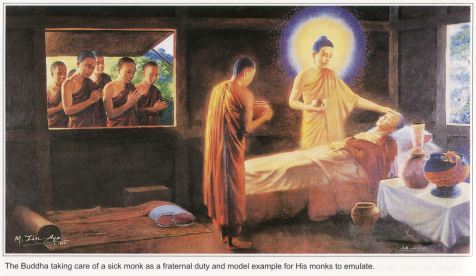
The Buddha taking care of a sick monk, named Tissa who had been neglected by his unthoughtful fellow monks. By so doing, the Buddha wanted to
foster mutual care and welfare amongst the Bhikkhus as well as others.
佛以照料生病的和尚,取名Tissa誰被忽視了他的unthoughtful同行僧侶。 By so doing, the Buddha wanted to foster mutual care and welfare amongst the Bhikkhus as well as others.這樣做,佛要促進相互之間的照顧和福利以及其他比丘。
1. The Buddha at Kusinara laid himself between two Sal trees with his head to the North, determined not to rise again. He them delivered his last
admonition, “Behold, 0 Disciples! I exhort you ! Subject to change are
all component things! Strive on with Diligence !” before He entered
Maha parinibbana (attainment of Final Emancipation).
2. Dona , the Brahman divided the Buddha’s relics into eight equal
portions and distributed each of them to the Rulers of the eight
countries. Then Dona decided that the golden container be kept for
himself as an object of respectful veneration.
1。佛陀奠定自己在庫系那拉兩薩爾和他的樹頭到北,堅決不復活。 He them delivered his last admonition, “Behold, 0 Disciples!他們發表的最後,他告誡,“看哪,0弟子! I exhort you !我勸你! Subject to change are all component things!如有變更,是所有組件的事情! Strive on with Diligence !” before He entered Maha parinibbana (attainment of Final Emancipation).努力與勤奮!“之前,他進入瑪哈 parinibbana(最後解放的程度)。
2. Dona , the Brahman divided the Buddha's relics into eight equal portions and distributed each of them to the Rulers of the eight
countries. 2。多納,婆羅門分為佛的遺物分為八份,分發給每一個平等的,他們對統治者的八個國家。 Then Dona decided that the golden container be kept for himself as an object of respectful veneration.然後,多納決定的金色容器保存為自己的崇拜對象的尊重。
. 。
.
